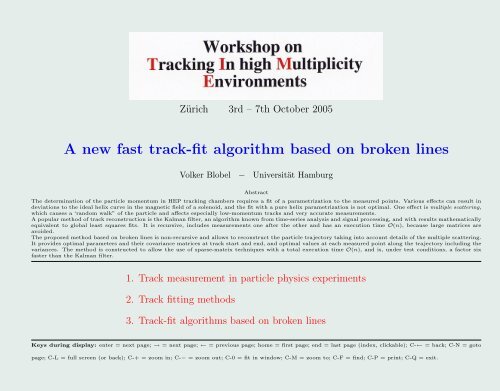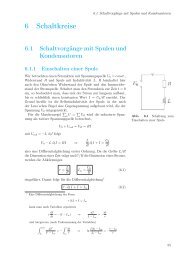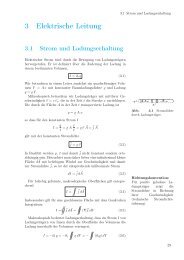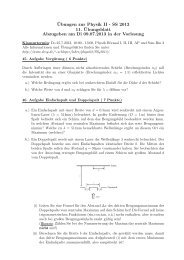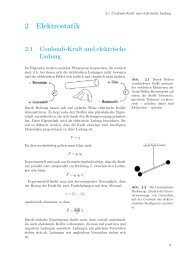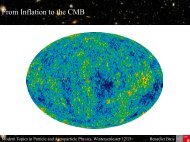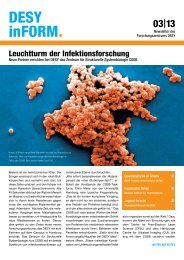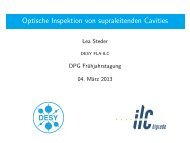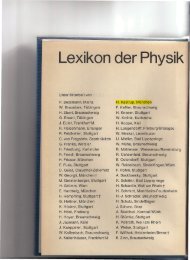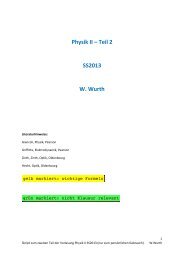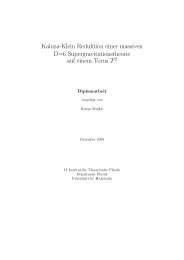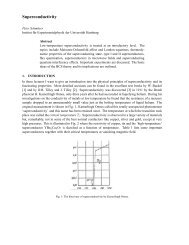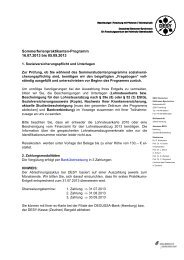A new fast track-fit algorithm based on broken lines - Desy
A new fast track-fit algorithm based on broken lines - Desy
A new fast track-fit algorithm based on broken lines - Desy
You also want an ePaper? Increase the reach of your titles
YUMPU automatically turns print PDFs into web optimized ePapers that Google loves.
Zürich 3rd – 7th October 2005<br />
A <str<strong>on</strong>g>new</str<strong>on</strong>g> <str<strong>on</strong>g>fast</str<strong>on</strong>g> <str<strong>on</strong>g>track</str<strong>on</strong>g>-<str<strong>on</strong>g>fit</str<strong>on</strong>g> <str<strong>on</strong>g>algorithm</str<strong>on</strong>g> <str<strong>on</strong>g>based</str<strong>on</strong>g> <strong>on</strong> <strong>broken</strong> <strong>lines</strong><br />
Volker Blobel − Universität Hamburg<br />
Abstract<br />
The determinati<strong>on</strong> of the particle momentum in HEP <str<strong>on</strong>g>track</str<strong>on</strong>g>ing chambers requires a <str<strong>on</strong>g>fit</str<strong>on</strong>g> of a parametrizati<strong>on</strong> to the measured points. Various effects can result in<br />
deviati<strong>on</strong>s to the ideal helix curve in the magnetic field of a solenoid, and the <str<strong>on</strong>g>fit</str<strong>on</strong>g> with a pure helix parametrizati<strong>on</strong> is not optimal. One effect is multiple scattering,<br />
which causes a ‘random walk” of the particle and affects especially low-momentum <str<strong>on</strong>g>track</str<strong>on</strong>g>s and very accurate measurements.<br />
A popular method of <str<strong>on</strong>g>track</str<strong>on</strong>g> rec<strong>on</strong>structi<strong>on</strong> is the Kalman filter, an <str<strong>on</strong>g>algorithm</str<strong>on</strong>g> known from time-series analysis and signal processing, and with results mathematically<br />
equivalent to global least squares <str<strong>on</strong>g>fit</str<strong>on</strong>g>s. It is recursive, includes measurements <strong>on</strong>e after the other and has an executi<strong>on</strong> time O(n), because large matrices are<br />
avoided.<br />
The proposed method <str<strong>on</strong>g>based</str<strong>on</strong>g> <strong>on</strong> <strong>broken</strong> <strong>lines</strong> is n<strong>on</strong>-recursive and allows to rec<strong>on</strong>struct the particle trajectory taking into account details of the multiple scattering.<br />
It provides optimal parameters and their covariance matrices at <str<strong>on</strong>g>track</str<strong>on</strong>g> start and end, and optimal values at each measured point al<strong>on</strong>g the trajectory including the<br />
variances. The method is c<strong>on</strong>structed to allow the use of sparse-matrix techniques with a total executi<strong>on</strong> time O(n), and is, under test c<strong>on</strong>diti<strong>on</strong>s, a factor six<br />
<str<strong>on</strong>g>fast</str<strong>on</strong>g>er than the Kalman filter.<br />
1. Track measurement in particle physics experiments<br />
2. Track <str<strong>on</strong>g>fit</str<strong>on</strong>g>ting methods<br />
3. Track-<str<strong>on</strong>g>fit</str<strong>on</strong>g> <str<strong>on</strong>g>algorithm</str<strong>on</strong>g>s <str<strong>on</strong>g>based</str<strong>on</strong>g> <strong>on</strong> <strong>broken</strong> <strong>lines</strong><br />
Keys during display: enter = next page; → = next page; ← = previous page; home = first page; end = last page (index, clickable); C-← = back; C-N = goto<br />
page; C-L = full screen (or back); C-+ = zoom in; C-− = zoom out; C-0 = <str<strong>on</strong>g>fit</str<strong>on</strong>g> in window; C-M = zoom to; C-F = find; C-P = print; C-Q = exit.
1. Track measurement in particle physics experiments<br />
e<br />
Run 270530 Event 157876 25/04/2000<br />
e’ p<br />
2 m<br />
K +<br />
π −<br />
π −<br />
5 cm 5 mm<br />
D −<br />
50 cm<br />
e’<br />
Charm event in the H1<br />
detector at HERA with<br />
drift chamber and vertex<br />
detector.<br />
LHC (2007 –): 1000 <str<strong>on</strong>g>track</str<strong>on</strong>g>s<br />
per event, several events<br />
per bunch crossing (bunch<br />
spacing 25 ns)<br />
Fast <str<strong>on</strong>g>track</str<strong>on</strong>g> rec<strong>on</strong>structi<strong>on</strong> is<br />
essential.<br />
V. Blobel – University of Hamburg A <str<strong>on</strong>g>new</str<strong>on</strong>g> <str<strong>on</strong>g>fast</str<strong>on</strong>g> <str<strong>on</strong>g>track</str<strong>on</strong>g>-<str<strong>on</strong>g>fit</str<strong>on</strong>g> <str<strong>on</strong>g>algorithm</str<strong>on</strong>g> <str<strong>on</strong>g>based</str<strong>on</strong>g> <strong>on</strong> <strong>broken</strong> <strong>lines</strong> page 2
Track parametrizati<strong>on</strong><br />
Ideal parametrizati<strong>on</strong>: a helix (κ, dca, φ, z0, tan λ) in a homogeneous magnetic field Bz with<br />
xy- or rφ-plane: circle, residual εi of a measured point (xi, yi) from a particle trajectory<br />
εi = 1<br />
2 κ � x 2 i + y 2 i + d 2 �<br />
ca − (1 + κdca) (xi sin φ − yi cos φ) + dca .<br />
sz-plane: straight line, residual εi of a measured point (si, zi)<br />
εi = z0 + (tan λ) · si − zi with si = <str<strong>on</strong>g>track</str<strong>on</strong>g> length in xy<br />
. . . but there are random and n<strong>on</strong>-random perturbati<strong>on</strong>s:<br />
Multiple scattering (msc): Elastic scattering of charged particles in the Coulomb field of the nuclei<br />
in the detector material. The mean of the projected deflecti<strong>on</strong> angle θ after traversing a material<br />
layer is zero and the distributi<strong>on</strong> has a variance of<br />
Multiple scattering deflecti<strong>on</strong>s<br />
will influence all downstream<br />
measurement in a correlated<br />
way, and delimits the momentum<br />
measurement at low mo-<br />
variance V [θ] ∝ t<br />
β 2 p 2 where t = ∆s/X0<br />
menta. si−1 si si+1 si+2<br />
×<br />
yi−1 ± σi−1<br />
Energy loss, Radiati<strong>on</strong> of electr<strong>on</strong>s, Field inhomogeneity, . . .<br />
×<br />
yi ± σi<br />
×<br />
yi+1 ± σi+1<br />
×<br />
yi+2 ± σi+2<br />
V. Blobel – University of Hamburg A <str<strong>on</strong>g>new</str<strong>on</strong>g> <str<strong>on</strong>g>fast</str<strong>on</strong>g> <str<strong>on</strong>g>track</str<strong>on</strong>g>-<str<strong>on</strong>g>fit</str<strong>on</strong>g> <str<strong>on</strong>g>algorithm</str<strong>on</strong>g> <str<strong>on</strong>g>based</str<strong>on</strong>g> <strong>on</strong> <strong>broken</strong> <strong>lines</strong> page 3
Track example with msc (magenta line is the true particle trajectory)<br />
Circle <str<strong>on</strong>g>fit</str<strong>on</strong>g><br />
0.05<br />
0<br />
-0.05<br />
Deviati<strong>on</strong>s from circle <str<strong>on</strong>g>fit</str<strong>on</strong>g><br />
R-phi projecti<strong>on</strong>: residual vs <str<strong>on</strong>g>track</str<strong>on</strong>g> length<br />
-0.1<br />
0 20 40 60 80<br />
→ <strong>broken</strong>-line <str<strong>on</strong>g>fit</str<strong>on</strong>g><br />
Large influence of multiple scattering (msc) • for low momenta,<br />
• for high positi<strong>on</strong> measurement accuracy, and<br />
• for dense material (large value of � s/X0).<br />
V. Blobel – University of Hamburg A <str<strong>on</strong>g>new</str<strong>on</strong>g> <str<strong>on</strong>g>fast</str<strong>on</strong>g> <str<strong>on</strong>g>track</str<strong>on</strong>g>-<str<strong>on</strong>g>fit</str<strong>on</strong>g> <str<strong>on</strong>g>algorithm</str<strong>on</strong>g> <str<strong>on</strong>g>based</str<strong>on</strong>g> <strong>on</strong> <strong>broken</strong> <strong>lines</strong> page 4
2. Track <str<strong>on</strong>g>fit</str<strong>on</strong>g>ting methods<br />
Track parameters are obtained by the <str<strong>on</strong>g>fit</str<strong>on</strong>g> of a <str<strong>on</strong>g>track</str<strong>on</strong>g> parametrizati<strong>on</strong> to the n measured <str<strong>on</strong>g>track</str<strong>on</strong>g> hits:<br />
0. Simple least square <str<strong>on</strong>g>fit</str<strong>on</strong>g> with ideal parametrizati<strong>on</strong> <str<strong>on</strong>g>fast</str<strong>on</strong>g>, with a computing time ∝ n<br />
2 ... 3<br />
1. Global <str<strong>on</strong>g>track</str<strong>on</strong>g> <str<strong>on</strong>g>fit</str<strong>on</strong>g>ting methods computing time ∝ n<br />
(either trajectory described by n<strong>on</strong>-diag<strong>on</strong>al n × n covariance matrix (matrix method), or by<br />
including parameters for N scattering planes, large matrix (breakpoint method);<br />
2. The progressive method (P. Billoir 1984) (≈ Kalman filter) computing time ∝ n<br />
<str<strong>on</strong>g>track</str<strong>on</strong>g> is followed by incorporating measurement after measurement, starting from the outer<br />
detector, improving the parameter vector and covariance matrix;<br />
2’. The Kalman filter (and smoothing) computing time ∝ n<br />
the state vector and its covariance matrix are propagated to the next measurement, additi<strong>on</strong>al<br />
error (msc . . . ) introduced as process noise; smoothing in directi<strong>on</strong> opposite to the filter.<br />
3. Broken-line <str<strong>on</strong>g>fit</str<strong>on</strong>g> (“<str<strong>on</strong>g>new</str<strong>on</strong>g>”) computing time ∝ n<br />
Results <strong>on</strong> <str<strong>on</strong>g>track</str<strong>on</strong>g> parameters from 1 to 3 are (almost) identical, and are, at low momentum, (roughly)<br />
up to 30 % better than simple <str<strong>on</strong>g>fit</str<strong>on</strong>g>.<br />
Track <str<strong>on</strong>g>fit</str<strong>on</strong>g>ting is not <strong>on</strong>ly required to obtain the final <str<strong>on</strong>g>track</str<strong>on</strong>g> parameters for physics analysis, but also in<br />
the <str<strong>on</strong>g>track</str<strong>on</strong>g>-finding phase (pattern recogniti<strong>on</strong>). Very many <str<strong>on</strong>g>fit</str<strong>on</strong>g>s of each <str<strong>on</strong>g>track</str<strong>on</strong>g> candidate are necessary to<br />
find the correct hits.<br />
V. Blobel – University of Hamburg A <str<strong>on</strong>g>new</str<strong>on</strong>g> <str<strong>on</strong>g>fast</str<strong>on</strong>g> <str<strong>on</strong>g>track</str<strong>on</strong>g>-<str<strong>on</strong>g>fit</str<strong>on</strong>g> <str<strong>on</strong>g>algorithm</str<strong>on</strong>g> <str<strong>on</strong>g>based</str<strong>on</strong>g> <strong>on</strong> <strong>broken</strong> <strong>lines</strong> page 5
Requirements and computing times<br />
Required results from a <str<strong>on</strong>g>track</str<strong>on</strong>g> <str<strong>on</strong>g>fit</str<strong>on</strong>g> <str<strong>on</strong>g>algorithm</str<strong>on</strong>g>:<br />
A: Optimal <str<strong>on</strong>g>track</str<strong>on</strong>g> parameters at <str<strong>on</strong>g>track</str<strong>on</strong>g>-start (vertex), for physics analysis;<br />
B: Correct covariance matrix for <str<strong>on</strong>g>track</str<strong>on</strong>g> parameters;<br />
C: Overall χ 2 of <str<strong>on</strong>g>track</str<strong>on</strong>g>, for test of quality of pattern recogniti<strong>on</strong>;<br />
D: Optimal <str<strong>on</strong>g>track</str<strong>on</strong>g> parameters at <str<strong>on</strong>g>track</str<strong>on</strong>g>-end, for extrapolati<strong>on</strong> to other detectors;<br />
E: χ 2 of each single hit, for outlier test and improvement of hit selecti<strong>on</strong>.<br />
Time for <strong>on</strong>e <str<strong>on</strong>g>track</str<strong>on</strong>g> <str<strong>on</strong>g>fit</str<strong>on</strong>g> (no magnetic field), in mikrosec<strong>on</strong>ds, <strong>on</strong> standard PC:<br />
Algorithm n = 25 n = 50 n = 100 Remarks:<br />
2-parameter least squares 0.270 0.420 0.720 bad <str<strong>on</strong>g>fit</str<strong>on</strong>g> in case of multiple scattering<br />
Matrix method 150.000 943.000 6731.000 <str<strong>on</strong>g>track</str<strong>on</strong>g>-start parameters: (A, B, C)<br />
Breakpoint method 117.000 556.000 2980.000 full rec<strong>on</strong>structi<strong>on</strong>: (A, B, C, D, E)<br />
Kalman backward 20.900 41.300 81.900 <str<strong>on</strong>g>track</str<strong>on</strong>g>-start parameters: (A, B)<br />
Kalman back-/forward approximately ×2 full rec<strong>on</strong>structi<strong>on</strong>: (A, B, C, D, E)<br />
Broken-line <str<strong>on</strong>g>fit</str<strong>on</strong>g> 6.550 12.980 25.200 full rec<strong>on</strong>structi<strong>on</strong>: (A, B, C, D, E)<br />
Track-start parameters from methods in last 5 rows (almost) identical.<br />
V. Blobel – University of Hamburg A <str<strong>on</strong>g>new</str<strong>on</strong>g> <str<strong>on</strong>g>fast</str<strong>on</strong>g> <str<strong>on</strong>g>track</str<strong>on</strong>g>-<str<strong>on</strong>g>fit</str<strong>on</strong>g> <str<strong>on</strong>g>algorithm</str<strong>on</strong>g> <str<strong>on</strong>g>based</str<strong>on</strong>g> <strong>on</strong> <strong>broken</strong> <strong>lines</strong> page 6
3. Track-<str<strong>on</strong>g>fit</str<strong>on</strong>g> <str<strong>on</strong>g>algorithm</str<strong>on</strong>g>s <str<strong>on</strong>g>based</str<strong>on</strong>g> <strong>on</strong> <strong>broken</strong> <strong>lines</strong><br />
Is a method possible, which keeps the good properties of the Kalman filter/smoothing and allows to<br />
get the complete soluti<strong>on</strong> in <strong>on</strong>e step?<br />
• Treat the multiple scattering in all detail, which generates necessarily many parameters and<br />
matrices of large dimensi<strong>on</strong>;<br />
• Use a mathematical model which results in equati<strong>on</strong>s with sparse matrices (many elements = 0),<br />
which can be solved quickly.<br />
Simple and <str<strong>on</strong>g>fast</str<strong>on</strong>g> least squares <str<strong>on</strong>g>track</str<strong>on</strong>g> <str<strong>on</strong>g>fit</str<strong>on</strong>g>s, with circle <str<strong>on</strong>g>fit</str<strong>on</strong>g> (Karimäkie) for κ, dca, φ and straight line <str<strong>on</strong>g>fit</str<strong>on</strong>g><br />
(z0, tan λ), are d<strong>on</strong>e to prepare the data for a detailed <str<strong>on</strong>g>fit</str<strong>on</strong>g>:<br />
• Momentum already known (from κ, tan λ) with some precisi<strong>on</strong>, allows to calculate multiple<br />
scattering variances;<br />
• Residuals in xy-plane and in sz-plane can be calculated;<br />
• A detailed <str<strong>on</strong>g>fit</str<strong>on</strong>g> follows, which takes into account multiple scattering (and other perturbati<strong>on</strong>s),<br />
applied to the residuals:<br />
(a) <str<strong>on</strong>g>fit</str<strong>on</strong>g> of z-residual versus <str<strong>on</strong>g>track</str<strong>on</strong>g> length s (straight line, no magnetic field);<br />
(b) <str<strong>on</strong>g>fit</str<strong>on</strong>g> of circle residuals versus <str<strong>on</strong>g>track</str<strong>on</strong>g> length s including curvature correcti<strong>on</strong> ∆κ.<br />
V. Blobel – University of Hamburg A <str<strong>on</strong>g>new</str<strong>on</strong>g> <str<strong>on</strong>g>fast</str<strong>on</strong>g> <str<strong>on</strong>g>track</str<strong>on</strong>g>-<str<strong>on</strong>g>fit</str<strong>on</strong>g> <str<strong>on</strong>g>algorithm</str<strong>on</strong>g> <str<strong>on</strong>g>based</str<strong>on</strong>g> <strong>on</strong> <strong>broken</strong> <strong>lines</strong> page 7
(a) Fit of z-residual versus <str<strong>on</strong>g>track</str<strong>on</strong>g> length Multiple scattering<br />
A charged particle traversing a material layer is deflected by many small-angle scatters, mostly due to<br />
Coulomb scattering from nuclei, with variance<br />
V [θ] = θ 2 0 =<br />
� 13.6 MeV<br />
βpc<br />
where t = ∆s/X0<br />
V<br />
� �<br />
θ<br />
=<br />
ψ<br />
� 2<br />
� �<br />
1 1/2<br />
θ<br />
1/2 1/3<br />
2 0<br />
t [1 + 0.038 ln t] 2<br />
ψ<br />
ψ<br />
∆s<br />
∆y<br />
Multiple scattering in a layer of finite thickness<br />
θ = projected angle of deflecti<strong>on</strong>, between directi<strong>on</strong> before and behind layer<br />
ψleft ≡ ψ, ψright ≡ θ − ψ = angles between the line, c<strong>on</strong>necting the two intersecti<strong>on</strong> points,<br />
and the directi<strong>on</strong> before and behind layer<br />
The line, c<strong>on</strong>necting the two intersecti<strong>on</strong> points, can be determined by a measurement. Relevant<br />
for the rec<strong>on</strong>structi<strong>on</strong> of the trajectory are the angles ψleft and ψright, with covariance matrix<br />
V<br />
� ψleft<br />
ψright<br />
�<br />
i<br />
=<br />
� �<br />
1/3 1/6<br />
θ<br />
1/6 1/3<br />
2 0,i<br />
for a homogeneous medium in layer i<br />
V. Blobel – University of Hamburg A <str<strong>on</strong>g>new</str<strong>on</strong>g> <str<strong>on</strong>g>fast</str<strong>on</strong>g> <str<strong>on</strong>g>track</str<strong>on</strong>g>-<str<strong>on</strong>g>fit</str<strong>on</strong>g> <str<strong>on</strong>g>algorithm</str<strong>on</strong>g> <str<strong>on</strong>g>based</str<strong>on</strong>g> <strong>on</strong> <strong>broken</strong> <strong>lines</strong> page 8<br />
θ
Two phases in the <str<strong>on</strong>g>track</str<strong>on</strong>g> rec<strong>on</strong>structi<strong>on</strong> Principles<br />
The particle <str<strong>on</strong>g>track</str<strong>on</strong>g>, given by the dotted<br />
curve, intersects the detector<br />
planes; the intersecti<strong>on</strong> points are<br />
drawn as circles. The result of the<br />
measurement are data points y ± σ,<br />
given by crosses with error bar.<br />
×<br />
yi−1 ± σi−1<br />
×<br />
yi ± σi<br />
si−1 si si+1 si+2<br />
×<br />
yi+1 ± σi+1<br />
×<br />
yi+2 ± σi+2<br />
Instead of using a <str<strong>on</strong>g>track</str<strong>on</strong>g> parametrizati<strong>on</strong> with e.g. intercept and slopes as parameters, the proposed<br />
<str<strong>on</strong>g>track</str<strong>on</strong>g>-<str<strong>on</strong>g>fit</str<strong>on</strong>g> method uses two phases in the <str<strong>on</strong>g>track</str<strong>on</strong>g> rec<strong>on</strong>structi<strong>on</strong>.<br />
(1) Rec<strong>on</strong>structi<strong>on</strong> of the trajectory:<br />
The trajectory, represented by the<br />
intersecti<strong>on</strong> points of the trajectory<br />
with the detector planes, is determined<br />
in a least squares <str<strong>on</strong>g>fit</str<strong>on</strong>g>; the<br />
<str<strong>on</strong>g>fit</str<strong>on</strong>g>ted estimates of the intersecti<strong>on</strong><br />
points are denoted by ui.<br />
ui−1<br />
βi−1<br />
ui<br />
βi<br />
ui+1 ui+2<br />
βi+1<br />
si−1 si si+1 si+2<br />
(2) Track parameter determinati<strong>on</strong>: From the <str<strong>on</strong>g>fit</str<strong>on</strong>g>ted ui-values the two <str<strong>on</strong>g>track</str<strong>on</strong>g> parameters intercept<br />
and slope, required for the physics analysis, are determined at both sides of the <str<strong>on</strong>g>track</str<strong>on</strong>g>.<br />
V. Blobel – University of Hamburg A <str<strong>on</strong>g>new</str<strong>on</strong>g> <str<strong>on</strong>g>fast</str<strong>on</strong>g> <str<strong>on</strong>g>track</str<strong>on</strong>g>-<str<strong>on</strong>g>fit</str<strong>on</strong>g> <str<strong>on</strong>g>algorithm</str<strong>on</strong>g> <str<strong>on</strong>g>based</str<strong>on</strong>g> <strong>on</strong> <strong>broken</strong> <strong>lines</strong> page 9
Kink angles<br />
The intersecti<strong>on</strong> points u of the particle <str<strong>on</strong>g>track</str<strong>on</strong>g> with detector planes, drawn as circles, are c<strong>on</strong>nected by<br />
straight <strong>lines</strong>. The kink angles β are the angles between adjacent straight <strong>lines</strong>.<br />
βi = ψright,i−1 − ψleft,i<br />
V [βi] = σ 2 β,i = V [ψright,i−1] + V [ψleft,i]<br />
(multiple scattering)<br />
ui−1<br />
βi−1<br />
ui<br />
βi<br />
ui+1 ui+2<br />
βi+1<br />
si−1 si si+1 si+2<br />
There are (n − 2) kink angles βi, which are linear functi<strong>on</strong>s of the values ui (with fi ≈ 1):<br />
�<br />
βi = fi ·<br />
1<br />
si+1 − si−1<br />
− ui<br />
+ ui+1<br />
1<br />
�<br />
ui−1<br />
si − si−1<br />
(si+1 − si) (si − si−1)<br />
si+1 − si<br />
The values ui are determined by minimizati<strong>on</strong> of the linear least squares expressi<strong>on</strong> (with weight<br />
wi = 1/σ 2 i )<br />
S (u) =<br />
n�<br />
wi (yi − ui) 2 +<br />
i=1<br />
�n−1<br />
with n + (n − 2) terms. Note: wi may be zero or very small (vertex <str<strong>on</strong>g>fit</str<strong>on</strong>g>).<br />
V. Blobel – University of Hamburg A <str<strong>on</strong>g>new</str<strong>on</strong>g> <str<strong>on</strong>g>fast</str<strong>on</strong>g> <str<strong>on</strong>g>track</str<strong>on</strong>g>-<str<strong>on</strong>g>fit</str<strong>on</strong>g> <str<strong>on</strong>g>algorithm</str<strong>on</strong>g> <str<strong>on</strong>g>based</str<strong>on</strong>g> <strong>on</strong> <strong>broken</strong> <strong>lines</strong> page 10<br />
i=2<br />
β 2 i<br />
σ 2 β,i
First phase: “Straight line” trajectory <str<strong>on</strong>g>fit</str<strong>on</strong>g><br />
The linear least squares expressi<strong>on</strong> S (u) is minimized by the soluti<strong>on</strong> u of the matrix equati<strong>on</strong>:<br />
Cu u = ru with the sparse n-by-n matrix<br />
⎛<br />
d<br />
⎜<br />
⎜x<br />
⎜<br />
⎜x<br />
⎜<br />
Cu = ⎜<br />
⎝<br />
x<br />
d<br />
x<br />
x<br />
x<br />
x<br />
d<br />
x<br />
x<br />
x<br />
x<br />
d<br />
x<br />
x<br />
x<br />
d<br />
x<br />
x<br />
. ..<br />
x<br />
⎞<br />
⎟<br />
⎠<br />
i.e. Cu is a symmetric n-by-n band matrix of bandwidth m = 2. The elements of Cu and ru are<br />
calculated by sums from the measured data.<br />
After a decompositi<strong>on</strong> Cu = LDL T the matrix equati<strong>on</strong> becomes L � DL T u � = r. L is a left unit<br />
triangular matrix and D is diag<strong>on</strong>al; the band structure is kept! The matrix Cu can be stored in a<br />
3-by-n array and the decompositi<strong>on</strong> can be made in-place.<br />
The soluti<strong>on</strong> can be obtained by the following calculati<strong>on</strong>s:<br />
decompose Cu = LDL T<br />
decompositi<strong>on</strong> (6n)<br />
solve Lv = ru for v by forward substituti<strong>on</strong> (2n)<br />
solve L T u = D −1 v for u by backward substituti<strong>on</strong> (3n)<br />
The last column gives the number of dot-instructi<strong>on</strong>s (multiplicati<strong>on</strong>, divisi<strong>on</strong>); the whole computati<strong>on</strong><br />
time is linear in n, i.e O(n) operati<strong>on</strong>s are necessary for the determinati<strong>on</strong> of u.<br />
V. Blobel – University of Hamburg A <str<strong>on</strong>g>new</str<strong>on</strong>g> <str<strong>on</strong>g>fast</str<strong>on</strong>g> <str<strong>on</strong>g>track</str<strong>on</strong>g>-<str<strong>on</strong>g>fit</str<strong>on</strong>g> <str<strong>on</strong>g>algorithm</str<strong>on</strong>g> <str<strong>on</strong>g>based</str<strong>on</strong>g> <strong>on</strong> <strong>broken</strong> <strong>lines</strong> page 11
Sec<strong>on</strong>d phase: Track parameters . . . and elements of the inverse matrix<br />
Correcti<strong>on</strong>s ∆z0 and ∆ (tan λ) are calculated from the two first u-values u1 and u2 amd added to the<br />
initial approximati<strong>on</strong>s �z0 and � (tan λ):<br />
⎛ ⎞ ⎛<br />
�z0 + u1<br />
z0<br />
⎝ ⎠ ⎜<br />
= ⎝<br />
(tan λ) (tan �λ)<br />
+ u2<br />
⎞<br />
⎟<br />
−<br />
⎠<br />
u1<br />
s2 − s1<br />
It is possible to calculate those elements of the inverse matrix Z = C −1<br />
u , which are in the band<br />
of the original matrix, in a computati<strong>on</strong> time linear in n ∗ ), using the decompositi<strong>on</strong> LDL T . For a<br />
bandwidth of m = 2 these are 6n operati<strong>on</strong>s, with restricti<strong>on</strong>s |i − k| ≤ m and |j − k| ≤ m<br />
for i = n . . . 1 : Zii = D −1<br />
ii −<br />
�i+2<br />
k=i+1<br />
Zik Lki<br />
Zij = −<br />
j+2 �<br />
k=j+1<br />
Zik Lkj<br />
j = i + 1, i + 2<br />
Starting with Znn, a sequence of computati<strong>on</strong> can be performed by calculating elements of Z in reverse<br />
order; when calculating Zij all required elements of Z are already calculated.<br />
By error propagati<strong>on</strong> the covariance matrix of the <str<strong>on</strong>g>track</str<strong>on</strong>g> parameters is calculated from the elements of<br />
V u ≡ Z.<br />
∗ ) K. Takahashi, J. Fagan and M. Chin, “Formati<strong>on</strong> of a sparse bus impedance matrix and its applicati<strong>on</strong>s to short circuit study”, Proceedings<br />
8th PICA C<strong>on</strong>ference (1973), Minneapolis, Minnesota<br />
V. Blobel – University of Hamburg A <str<strong>on</strong>g>new</str<strong>on</strong>g> <str<strong>on</strong>g>fast</str<strong>on</strong>g> <str<strong>on</strong>g>track</str<strong>on</strong>g>-<str<strong>on</strong>g>fit</str<strong>on</strong>g> <str<strong>on</strong>g>algorithm</str<strong>on</strong>g> <str<strong>on</strong>g>based</str<strong>on</strong>g> <strong>on</strong> <strong>broken</strong> <strong>lines</strong> page 12
(b) Fit of circle residuals versus <str<strong>on</strong>g>track</str<strong>on</strong>g> length<br />
In additi<strong>on</strong> to the parameters in case (a) now a curvature correcti<strong>on</strong> ∆κ has to be determined. The<br />
mean value of the ”kink angle” βi, as defined before (a), is now different from zero, due to the magnetic<br />
deflecti<strong>on</strong>.<br />
This magnetic deflecti<strong>on</strong> is taken into account by the re-definiti<strong>on</strong><br />
�<br />
βi ≈ fi ·<br />
1<br />
si+1 − si−1<br />
− ui<br />
+ ui+1<br />
1<br />
ui−1<br />
si − si−1<br />
(si+1 − si) (si − si−1)<br />
(ai is the distance between the points i and i + 1)<br />
with E [βi] = 0 and this has to be used in the functi<strong>on</strong> S<br />
S (u, ∆κ) =<br />
n� (yi − ui) 2<br />
+<br />
i=1<br />
σ 2 i<br />
si+1 − si<br />
�n−1<br />
which has to be minimized with respect to the values ui and ∆κ.<br />
i=2<br />
β 2 i<br />
σ 2 β,i<br />
�<br />
+ 1<br />
2 (ai−1 + ai) · ∆κ<br />
V. Blobel – University of Hamburg A <str<strong>on</strong>g>new</str<strong>on</strong>g> <str<strong>on</strong>g>fast</str<strong>on</strong>g> <str<strong>on</strong>g>track</str<strong>on</strong>g>-<str<strong>on</strong>g>fit</str<strong>on</strong>g> <str<strong>on</strong>g>algorithm</str<strong>on</strong>g> <str<strong>on</strong>g>based</str<strong>on</strong>g> <strong>on</strong> <strong>broken</strong> <strong>lines</strong> page 13
First phase: “Curved line” trajectory <str<strong>on</strong>g>fit</str<strong>on</strong>g><br />
The case of the additi<strong>on</strong>al parameter ∆κ is <strong>on</strong>ly slightly more complicated. The linear least squares<br />
expressi<strong>on</strong> S (u, ∆κ) is minimized by the soluti<strong>on</strong> of the matrix equati<strong>on</strong>:<br />
⎛<br />
Cκ c<br />
⎜<br />
⎝<br />
T<br />
⎞ ⎛ ⎞<br />
∆κ<br />
⎟ ⎜ ⎟<br />
⎟ ⎜ ⎟<br />
c Cu ⎠ ⎝ u ⎠ =<br />
⎛<br />
⎞<br />
Cκ c c c c c c c · · ·<br />
⎜<br />
⎛ ⎞<br />
⎜<br />
c d x x<br />
⎟<br />
⎜<br />
rκ<br />
⎜<br />
c x d x x<br />
⎟<br />
⎜ ⎟<br />
⎜<br />
⎜ ⎟<br />
⎜<br />
c x x d x x<br />
⎟<br />
⎝ru⎠<br />
with matrix ⎜<br />
c x x d x x ⎟<br />
⎜<br />
c x x d x x ⎟<br />
⎜<br />
.<br />
⎝ c<br />
.. ⎟<br />
⎠<br />
i.e. the matrix is a bordered band matrix.<br />
Soluti<strong>on</strong>: Cu = LDL T<br />
.<br />
decompositi<strong>on</strong> (6n)<br />
Cuz = c soluti<strong>on</strong> for z (5n)<br />
Bκ = � Cκ − c T z �−1 �<br />
∆κ = Bκ rκ − z<br />
variance of curvature (n + 1)<br />
T �<br />
ru curvature (n + 1)<br />
Cu�u = ru soluti<strong>on</strong> for �u (5n)<br />
u = �u − z∆κ smoothed coordinates (n)<br />
V. Blobel – University of Hamburg A <str<strong>on</strong>g>new</str<strong>on</strong>g> <str<strong>on</strong>g>fast</str<strong>on</strong>g> <str<strong>on</strong>g>track</str<strong>on</strong>g>-<str<strong>on</strong>g>fit</str<strong>on</strong>g> <str<strong>on</strong>g>algorithm</str<strong>on</strong>g> <str<strong>on</strong>g>based</str<strong>on</strong>g> <strong>on</strong> <strong>broken</strong> <strong>lines</strong> page 14
Sec<strong>on</strong>d phase: Track parameters<br />
The curvature correcti<strong>on</strong> ∆κ is already calculated; the correcti<strong>on</strong>s for positi<strong>on</strong> and directi<strong>on</strong> are<br />
calculated, as before, from u1 and u2, with covariance matrix by error propagati<strong>on</strong>.<br />
The complete inverse matrix of the bordered band matrix is written here,<br />
⎛<br />
⎜<br />
⎝<br />
Cκ<br />
c T<br />
c Cu<br />
⎞<br />
⎟<br />
⎠<br />
−1<br />
=<br />
⎛<br />
⎜<br />
⎝<br />
Bκ<br />
−zBκ<br />
although <strong>on</strong>ly few elements are required, e.g. the element<br />
Vu,12 = � C −1�<br />
u<br />
12 + Bκ · z1 z2<br />
−Bκz T<br />
C −1<br />
u + zBκz T<br />
Note: The matrices Cκ and Bκ are in this applicati<strong>on</strong> scalars (<strong>on</strong>ly <strong>on</strong>e comm<strong>on</strong> parameter). They become 2-by-2<br />
matrices, if two comm<strong>on</strong> parameters are determined, e.g. ∆κ and ∆T0 (drift chamber time zero). The above formulas<br />
remain valid.<br />
V. Blobel – University of Hamburg A <str<strong>on</strong>g>new</str<strong>on</strong>g> <str<strong>on</strong>g>fast</str<strong>on</strong>g> <str<strong>on</strong>g>track</str<strong>on</strong>g>-<str<strong>on</strong>g>fit</str<strong>on</strong>g> <str<strong>on</strong>g>algorithm</str<strong>on</strong>g> <str<strong>on</strong>g>based</str<strong>on</strong>g> <strong>on</strong> <strong>broken</strong> <strong>lines</strong> page 15<br />
⎞<br />
⎟<br />
⎠ ,
Broken-line <str<strong>on</strong>g>track</str<strong>on</strong>g> <str<strong>on</strong>g>fit</str<strong>on</strong>g> result Momentum 200 MeV/c<br />
0.05<br />
0<br />
-0.05<br />
-0.1<br />
Blue line and yellow band is <str<strong>on</strong>g>fit</str<strong>on</strong>g> ±1σ<br />
R-phi projecti<strong>on</strong>: residual vs <str<strong>on</strong>g>track</str<strong>on</strong>g> length<br />
0 20 40 60 80<br />
The <strong>broken</strong>-line <str<strong>on</strong>g>fit</str<strong>on</strong>g> result is given as blue <strong>broken</strong>-line with a ±1 standard deviati<strong>on</strong> yellow band, with<br />
extrapolati<strong>on</strong> to the vertex at s = 0 (weight in <str<strong>on</strong>g>fit</str<strong>on</strong>g> was w1 = 0). ← back<br />
V. Blobel – University of Hamburg A <str<strong>on</strong>g>new</str<strong>on</strong>g> <str<strong>on</strong>g>fast</str<strong>on</strong>g> <str<strong>on</strong>g>track</str<strong>on</strong>g>-<str<strong>on</strong>g>fit</str<strong>on</strong>g> <str<strong>on</strong>g>algorithm</str<strong>on</strong>g> <str<strong>on</strong>g>based</str<strong>on</strong>g> <strong>on</strong> <strong>broken</strong> <strong>lines</strong> page 16
Accuracy vs momentum Lutz detector<br />
Thick red and thick blue <strong>lines</strong>: error from histogram <str<strong>on</strong>g>fit</str<strong>on</strong>g> (red) and calculated error (blue) for<br />
<strong>broken</strong>-line <str<strong>on</strong>g>fit</str<strong>on</strong>g>, with improvements by 37 % (momentum), by 31 % (dca) and 17 % (φ) at lowest<br />
momentum.<br />
Thin dotted <strong>lines</strong>: error from histogram <str<strong>on</strong>g>fit</str<strong>on</strong>g> (red) and calculated error (blue) for simple LS <str<strong>on</strong>g>fit</str<strong>on</strong>g><br />
0.1<br />
0.01<br />
Curvature (relative error)<br />
0.001<br />
0.1 1 10 100<br />
momentum [GeV/c]<br />
0.01<br />
0.001<br />
Distance of closest approach<br />
0.1 1 10 100<br />
momentum [GeV/c]<br />
→ calculated errors are realistic for whole momentum range!<br />
G. Lutz, Optimum <str<strong>on</strong>g>track</str<strong>on</strong>g> <str<strong>on</strong>g>fit</str<strong>on</strong>g>ting in the presence of multiple scattering, NIMA 273 (1988) 349 – 361<br />
0.001<br />
1E-4<br />
Phi - azimuthal angle<br />
0.1 1 10 100<br />
momentum [GeV/c]<br />
V. Blobel – University of Hamburg A <str<strong>on</strong>g>new</str<strong>on</strong>g> <str<strong>on</strong>g>fast</str<strong>on</strong>g> <str<strong>on</strong>g>track</str<strong>on</strong>g>-<str<strong>on</strong>g>fit</str<strong>on</strong>g> <str<strong>on</strong>g>algorithm</str<strong>on</strong>g> <str<strong>on</strong>g>based</str<strong>on</strong>g> <strong>on</strong> <strong>broken</strong> <strong>lines</strong> page 17
Summary . . . <strong>on</strong> <strong>broken</strong>-line <str<strong>on</strong>g>algorithm</str<strong>on</strong>g><br />
Improved accuracy with correct covariance matrix: Improvement of the <str<strong>on</strong>g>track</str<strong>on</strong>g> rec<strong>on</strong>structi<strong>on</strong><br />
precisi<strong>on</strong> for <str<strong>on</strong>g>track</str<strong>on</strong>g>s of low momentum in a dense detector, for high<br />
positi<strong>on</strong> measurement accuracy. Extensi<strong>on</strong> to include energy loss (deterministic)<br />
for heavy particles, and magnetic-field inhomogenities are possible.<br />
Full informati<strong>on</strong>: The <str<strong>on</strong>g>algorithm</str<strong>on</strong>g> gives the full informati<strong>on</strong> <strong>on</strong> every measured point<br />
<strong>on</strong> a trajectory:<br />
<str<strong>on</strong>g>fit</str<strong>on</strong>g>ted value with propagated error, pull of positi<strong>on</strong> and kink angle<br />
and this informati<strong>on</strong> can be used already during <str<strong>on</strong>g>track</str<strong>on</strong>g> finding, to remove bad hits<br />
or to cut the trajectory, and to adjust material assumpti<strong>on</strong>.<br />
Outlier down-weighting: Outliers can be recognized; repeated <str<strong>on</strong>g>fit</str<strong>on</strong>g> with down-weighted<br />
hits d<strong>on</strong>e in reduced time.<br />
Broken-line <str<strong>on</strong>g>fit</str<strong>on</strong>g>s: New <str<strong>on</strong>g>algorithm</str<strong>on</strong>g>, <str<strong>on</strong>g>fast</str<strong>on</strong>g>er by factor ≈ 6 in comparis<strong>on</strong> to Kalman filter<br />
(under test c<strong>on</strong>diti<strong>on</strong>s), with <str<strong>on</strong>g>fit</str<strong>on</strong>g> in <strong>on</strong>e step (no initial values, no iterati<strong>on</strong>, no<br />
recursi<strong>on</strong>, no directi<strong>on</strong> backward or forward) in time O(n).<br />
V. Blobel – University of Hamburg A <str<strong>on</strong>g>new</str<strong>on</strong>g> <str<strong>on</strong>g>fast</str<strong>on</strong>g> <str<strong>on</strong>g>track</str<strong>on</strong>g>-<str<strong>on</strong>g>fit</str<strong>on</strong>g> <str<strong>on</strong>g>algorithm</str<strong>on</strong>g> <str<strong>on</strong>g>based</str<strong>on</strong>g> <strong>on</strong> <strong>broken</strong> <strong>lines</strong> page 18
Backup slides<br />
• 200 MeV/c <str<strong>on</strong>g>track</str<strong>on</strong>g> with multiple scattering<br />
• . . . with <strong>broken</strong>-line <str<strong>on</strong>g>fit</str<strong>on</strong>g><br />
• χ 2 - and P -values<br />
• Pulls of positi<strong>on</strong> measurement<br />
• Pulls of kink angle measurement<br />
• Outlier examples<br />
• A large-angle scatter<br />
V. Blobel – University of Hamburg A <str<strong>on</strong>g>new</str<strong>on</strong>g> <str<strong>on</strong>g>fast</str<strong>on</strong>g> <str<strong>on</strong>g>track</str<strong>on</strong>g>-<str<strong>on</strong>g>fit</str<strong>on</strong>g> <str<strong>on</strong>g>algorithm</str<strong>on</strong>g> <str<strong>on</strong>g>based</str<strong>on</strong>g> <strong>on</strong> <strong>broken</strong> <strong>lines</strong> page 19
Track with multiple scattering 200 MeV/c<br />
0.05<br />
0<br />
-0.05<br />
R-phi projecti<strong>on</strong>: residual vs <str<strong>on</strong>g>track</str<strong>on</strong>g> length<br />
0 20 40 60 80<br />
Magenta line is the true particle trajectory, with large kink angles in beam pipe, chamber walls etc.<br />
V. Blobel – University of Hamburg A <str<strong>on</strong>g>new</str<strong>on</strong>g> <str<strong>on</strong>g>fast</str<strong>on</strong>g> <str<strong>on</strong>g>track</str<strong>on</strong>g>-<str<strong>on</strong>g>fit</str<strong>on</strong>g> <str<strong>on</strong>g>algorithm</str<strong>on</strong>g> <str<strong>on</strong>g>based</str<strong>on</strong>g> <strong>on</strong> <strong>broken</strong> <strong>lines</strong> page 20
. . . with <strong>broken</strong>-line <str<strong>on</strong>g>fit</str<strong>on</strong>g> residual vs. <str<strong>on</strong>g>track</str<strong>on</strong>g> length<br />
0.05<br />
0<br />
-0.05<br />
R-phi projecti<strong>on</strong>: residual vs <str<strong>on</strong>g>track</str<strong>on</strong>g> length<br />
0 20 40 60 80<br />
The <strong>broken</strong>-line <str<strong>on</strong>g>fit</str<strong>on</strong>g> result is given as a ±1 standard deviati<strong>on</strong> band, with extrapolati<strong>on</strong> to the vertex<br />
at s = 0 (weight in <str<strong>on</strong>g>fit</str<strong>on</strong>g> was w1 = 0).<br />
V. Blobel – University of Hamburg A <str<strong>on</strong>g>new</str<strong>on</strong>g> <str<strong>on</strong>g>fast</str<strong>on</strong>g> <str<strong>on</strong>g>track</str<strong>on</strong>g>-<str<strong>on</strong>g>fit</str<strong>on</strong>g> <str<strong>on</strong>g>algorithm</str<strong>on</strong>g> <str<strong>on</strong>g>based</str<strong>on</strong>g> <strong>on</strong> <strong>broken</strong> <strong>lines</strong> page 21
χ 2 - and P -values Goodness-of-<str<strong>on</strong>g>fit</str<strong>on</strong>g><br />
with n <str<strong>on</strong>g>fit</str<strong>on</strong>g>ted parameters.<br />
1500<br />
1000<br />
500<br />
χ 2 (n−2) ≡ S(u)min = χ 2 (n measurements) + χ 2 (n − 2 kink angles)<br />
0<br />
0 0.5 1<br />
P-value distributi<strong>on</strong><br />
Number of degrees of freedom = n − 2<br />
1000<br />
500<br />
0<br />
0 0.5 1<br />
P-value distributi<strong>on</strong><br />
P -value distributi<strong>on</strong> for the momenta of 0.5 GeV/c (left, mean value of χ 2 = 99.2) and 10 GeV/c<br />
(right, mean value of χ 2 = 97.4) are shown from the trajectory <str<strong>on</strong>g>fit</str<strong>on</strong>g><br />
for a modified H1 c<strong>on</strong>figurati<strong>on</strong> (2 CST hits plus 98 drift chamber hits) in a vertex <str<strong>on</strong>g>fit</str<strong>on</strong>g> with a standard<br />
deviati<strong>on</strong> of 30 µm.<br />
V. Blobel – University of Hamburg A <str<strong>on</strong>g>new</str<strong>on</strong>g> <str<strong>on</strong>g>fast</str<strong>on</strong>g> <str<strong>on</strong>g>track</str<strong>on</strong>g>-<str<strong>on</strong>g>fit</str<strong>on</strong>g> <str<strong>on</strong>g>algorithm</str<strong>on</strong>g> <str<strong>on</strong>g>based</str<strong>on</strong>g> <strong>on</strong> <strong>broken</strong> <strong>lines</strong> page 22
Pulls of positi<strong>on</strong> measurement<br />
The pull of the positi<strong>on</strong> measurement is defined as the difference of the measured and <str<strong>on</strong>g>fit</str<strong>on</strong>g>ted positi<strong>on</strong>,<br />
divided by the standard deviati<strong>on</strong> of the difference:<br />
E 03<br />
400<br />
200<br />
m = -0.03E-03 +- 0.32E-03<br />
py,i =<br />
s = 1.0002 +- 0.24E-03<br />
0<br />
-4 -2 0 2 4<br />
Pull of positi<strong>on</strong> measurement<br />
yi − ui<br />
� σ 2 i − (V u) ii<br />
E 03<br />
400<br />
200<br />
m = -0.02E-03 +- 0.32E-03<br />
s = 0.9959 +- 0.24E-03<br />
0<br />
-4 -2 0 2 4<br />
Pull of positi<strong>on</strong> measurement<br />
The pulls follow the expected N(0, 1) distributi<strong>on</strong> for a momentum of 0.5 GeV/c (left) and for a<br />
momentum of 10 GeV/c (right) (H1 detector c<strong>on</strong>figurati<strong>on</strong> with 2 CST and 56 CJC hits).<br />
V. Blobel – University of Hamburg A <str<strong>on</strong>g>new</str<strong>on</strong>g> <str<strong>on</strong>g>fast</str<strong>on</strong>g> <str<strong>on</strong>g>track</str<strong>on</strong>g>-<str<strong>on</strong>g>fit</str<strong>on</strong>g> <str<strong>on</strong>g>algorithm</str<strong>on</strong>g> <str<strong>on</strong>g>based</str<strong>on</strong>g> <strong>on</strong> <strong>broken</strong> <strong>lines</strong> page 23
Pulls of kink angle measurement<br />
The pull of the kink angle is defined as the difference of the expected (zero) and <str<strong>on</strong>g>fit</str<strong>on</strong>g>ted angle, divided<br />
by the standard deviati<strong>on</strong> of the difference:<br />
pβ,i =<br />
βi<br />
�<br />
σ 2 β,i − (V β) ii<br />
where V β is calculated by error propagati<strong>on</strong> from the covariance matrix V u.<br />
E 03<br />
400<br />
200<br />
m = 0.8E-03 +- 0.36E-03<br />
s = 1.1244 +- 0.27E-03<br />
0<br />
-4 -2 0 2 4<br />
Pull of kink angle<br />
E 03<br />
200<br />
1E5<br />
,<br />
m = 0.00151 +- 0.32E-03<br />
s = 1.0007 +- 0.24E-03<br />
0<br />
-4 -2 0 2 4<br />
Pull of kink angle<br />
The pulls follow almost the expected N(0, 1) distributi<strong>on</strong> for a momentum of 0.5 GeV/c (left) and for<br />
a momentum of 10 GeV/c (right).<br />
V. Blobel – University of Hamburg A <str<strong>on</strong>g>new</str<strong>on</strong>g> <str<strong>on</strong>g>fast</str<strong>on</strong>g> <str<strong>on</strong>g>track</str<strong>on</strong>g>-<str<strong>on</strong>g>fit</str<strong>on</strong>g> <str<strong>on</strong>g>algorithm</str<strong>on</strong>g> <str<strong>on</strong>g>based</str<strong>on</strong>g> <strong>on</strong> <strong>broken</strong> <strong>lines</strong> page 24
Outlier example 1 200 MeV/c, 6σ outlier<br />
0.05<br />
0<br />
-0.05<br />
-0.1<br />
R-phi projecti<strong>on</strong>: residual vs <str<strong>on</strong>g>track</str<strong>on</strong>g> length<br />
0 20 40 60 80<br />
V. Blobel – University of Hamburg A <str<strong>on</strong>g>new</str<strong>on</strong>g> <str<strong>on</strong>g>fast</str<strong>on</strong>g> <str<strong>on</strong>g>track</str<strong>on</strong>g>-<str<strong>on</strong>g>fit</str<strong>on</strong>g> <str<strong>on</strong>g>algorithm</str<strong>on</strong>g> <str<strong>on</strong>g>based</str<strong>on</strong>g> <strong>on</strong> <strong>broken</strong> <strong>lines</strong> page 25
Outlier example 2 1 GeV/c, 6σ outlier<br />
0.1<br />
0.05<br />
0<br />
R-phi projecti<strong>on</strong>: residual vs <str<strong>on</strong>g>track</str<strong>on</strong>g> length<br />
0 20 40 60 80<br />
V. Blobel – University of Hamburg A <str<strong>on</strong>g>new</str<strong>on</strong>g> <str<strong>on</strong>g>fast</str<strong>on</strong>g> <str<strong>on</strong>g>track</str<strong>on</strong>g>-<str<strong>on</strong>g>fit</str<strong>on</strong>g> <str<strong>on</strong>g>algorithm</str<strong>on</strong>g> <str<strong>on</strong>g>based</str<strong>on</strong>g> <strong>on</strong> <strong>broken</strong> <strong>lines</strong> page 26
Outlier example 3 200 MeV/c, 6σ outlier<br />
0.1<br />
0.05<br />
0<br />
-0.05<br />
R-phi projecti<strong>on</strong>: residual vs <str<strong>on</strong>g>track</str<strong>on</strong>g> length<br />
0 20 40 60 80<br />
V. Blobel – University of Hamburg A <str<strong>on</strong>g>new</str<strong>on</strong>g> <str<strong>on</strong>g>fast</str<strong>on</strong>g> <str<strong>on</strong>g>track</str<strong>on</strong>g>-<str<strong>on</strong>g>fit</str<strong>on</strong>g> <str<strong>on</strong>g>algorithm</str<strong>on</strong>g> <str<strong>on</strong>g>based</str<strong>on</strong>g> <strong>on</strong> <strong>broken</strong> <strong>lines</strong> page 27
Outlier example 4 200 MeV/c, 6σ outlier<br />
0.05<br />
0<br />
-0.05<br />
-0.1<br />
R-phi projecti<strong>on</strong>: residual vs <str<strong>on</strong>g>track</str<strong>on</strong>g> length<br />
0 20 40 60 80<br />
V. Blobel – University of Hamburg A <str<strong>on</strong>g>new</str<strong>on</strong>g> <str<strong>on</strong>g>fast</str<strong>on</strong>g> <str<strong>on</strong>g>track</str<strong>on</strong>g>-<str<strong>on</strong>g>fit</str<strong>on</strong>g> <str<strong>on</strong>g>algorithm</str<strong>on</strong>g> <str<strong>on</strong>g>based</str<strong>on</strong>g> <strong>on</strong> <strong>broken</strong> <strong>lines</strong> page 28
A large-angle scatter<br />
A 1 GeV/c <str<strong>on</strong>g>track</str<strong>on</strong>g> with an artificial 1 ◦ kink around s = 42 cm:<br />
0.4<br />
0.2<br />
0<br />
20 40 60<br />
The kink angle is much larger than the rms multiple scattering angle, expected for 1 GeV/c.<br />
The overall χ 2 of the trajectory <str<strong>on</strong>g>fit</str<strong>on</strong>g> (blue curve) is large.<br />
V. Blobel – University of Hamburg A <str<strong>on</strong>g>new</str<strong>on</strong>g> <str<strong>on</strong>g>fast</str<strong>on</strong>g> <str<strong>on</strong>g>track</str<strong>on</strong>g>-<str<strong>on</strong>g>fit</str<strong>on</strong>g> <str<strong>on</strong>g>algorithm</str<strong>on</strong>g> <str<strong>on</strong>g>based</str<strong>on</strong>g> <strong>on</strong> <strong>broken</strong> <strong>lines</strong> page 29
C<strong>on</strong>tents<br />
1. Track measurement in particle physics experiments<br />
2<br />
Track parametrizati<strong>on</strong> . . . . . . . . . . . . . . . 3<br />
Track example with msc . . . . . . . . . . . . . . 4<br />
2. Track <str<strong>on</strong>g>fit</str<strong>on</strong>g>ting methods 5<br />
Requirements and computing times . . . . . . . . 6<br />
3. Track-<str<strong>on</strong>g>fit</str<strong>on</strong>g> <str<strong>on</strong>g>algorithm</str<strong>on</strong>g>s <str<strong>on</strong>g>based</str<strong>on</strong>g> <strong>on</strong> <strong>broken</strong> <strong>lines</strong> 7<br />
(a) Fit of z-residual versus <str<strong>on</strong>g>track</str<strong>on</strong>g> length . . . . . 8<br />
Two phases in the <str<strong>on</strong>g>track</str<strong>on</strong>g> rec<strong>on</strong>structi<strong>on</strong> . . . . . . 9<br />
Kink angles . . . . . . . . . . . . . . . . . . . . . 10<br />
First phase: “Straight line” trajectory <str<strong>on</strong>g>fit</str<strong>on</strong>g> . . . . 11<br />
Sec<strong>on</strong>d phase: Track parameters . . . . . . . . . 12<br />
(b) Fit of circle residuals versus <str<strong>on</strong>g>track</str<strong>on</strong>g> length . . . 13<br />
First phase: “Curved line” trajectory <str<strong>on</strong>g>fit</str<strong>on</strong>g> . . . . . 14<br />
Sec<strong>on</strong>d phase: Track parameters . . . . . . . . . 15<br />
Broken-line <str<strong>on</strong>g>track</str<strong>on</strong>g> <str<strong>on</strong>g>fit</str<strong>on</strong>g> result . . . . . . . . . . . . . 16<br />
Accuracy vs momentum . . . . . . . . . . . . . . 17<br />
Summary 18<br />
Backup slides 19<br />
Track with multiple scattering . . . . . . . . . . 20<br />
. . . with <strong>broken</strong>-line <str<strong>on</strong>g>fit</str<strong>on</strong>g> . . . . . . . . . . . . . . . 21<br />
χ 2 - and P -values . . . . . . . . . . . . . . . . . . 22<br />
Pulls of positi<strong>on</strong> measurement . . . . . . . . . . . 23<br />
Pulls of kink angle measurement . . . . . . . . . 24<br />
Outlier example 1 . . . . . . . . . . . . . . . . . 25<br />
Outlier example 2 . . . . . . . . . . . . . . . . . 26<br />
Outlier example 3 . . . . . . . . . . . . . . . . . 27<br />
Outlier example 4 . . . . . . . . . . . . . . . . . 28<br />
A large-angle scatter . . . . . . . . . . . . . . . . 29<br />
Table of c<strong>on</strong>tents 30


